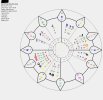EmeraldHope said:
I do not know anything very in depth about astrology, other than the basics of the signs, etc. I had read in another thread that your natal chart could be a general outline tool that maybe helpful in working. I've had mine for a while, but really do not know how to make any use of it.
I have always thought it odd that my sun, moon, and mercury are all in pisces. If anyone has any in depth knowledge on chart reading, what is practical understanding of that? Or a good resource to figure it out myself?
Sun, Moon and Mercury in Pisces could mean many things, depending if early degree, in which case the Fixed Stars Enif and Fomalhaut, the Nose of Pegasus and the Watcher of the South, Gabriel would be conjunct; or late degree Pisces, such as 24 or 28 degrees, where Fixed Stars Sadalbari and Scheat are found in the constellation Pegasus as well.
There is no single good resource as far as I am concerned but if you want to get into old astrologers, and therefore traditional methods of interpretation and meaning, Ptolemy wrote Tetrabiblos in 3rd Century, there are Arabic and Egyptian methods dating back earlier,, then there will be modern interps like Liz Greene, Alan Leo, Marc Edmund Jones, Dane Rudhyar and quite a few more well known authors in the genre.
Robert Pelletier has written some solid books as has Isabel Hickey.
Martin Gansten or Rumen Kolev are recommended for reading technical formulae in how the mathematics plays into astrology when delineating the angles, Ascendant, Midheaven, Descendant and Nadir as well as techniques of progression such as primary motion or solar arcs.
There are more schools of thought about the origins, applications and interpretations of astrology than I know. Sidereal, heliocentric, draconic, medieval, babylonian, egyptian, esoteric, uranian, modern and traditional for starters.
Mercury is in detriment in Pisces. Pisces is the polar opposite or other side of the coin to Virgo which is ruled by Mercury. In Pisces the Mercurial traits of intellect, wit, rationality and communication are "watered down" which is to say dependent more on feeling and intuition than rational thought.
The Sun and Moon in Pisces, depending if they are conjunct, etc, indicates an intensely sensitive person who cannot really escape the feeling and emotional state, tends to be very empathetic, sympathetic, musically and artistically inclined, certainly appreciative, often expressing talent and interest in the healing modalities such as massage therapy, yoga, reiki, etc.
Depending on whether Pisces is on an angle determines the strength of importance in the chart, though with Sun, Moon and Mercury in Pisces I cannot imagine another sign in your chart having more predominance, though could be.
http://penelope.uchicago.edu/Thayer/E/Roman/Texts/Ptolemy/Tetrabiblos/home.html
http://www.constellationsofwords.com/Constellations/Pisces.html#Fixed_stars_in_
http://www.constellationsofwords.com/stars/Fomalhaut.html
Astrowin.org has a good free natal interpretation I think, Chaos Astrology is OK, Astro.com is popular and solid.
Of the three if you choose one to enter chart details I recommend Astrowin.
:)

 I haver never learned to calculate a chart by hand, and am not very good at mathematics, so Astrology didn't become a study until I got my first computer (thank you magic machine)
I haver never learned to calculate a chart by hand, and am not very good at mathematics, so Astrology didn't become a study until I got my first computer (thank you magic machine)




